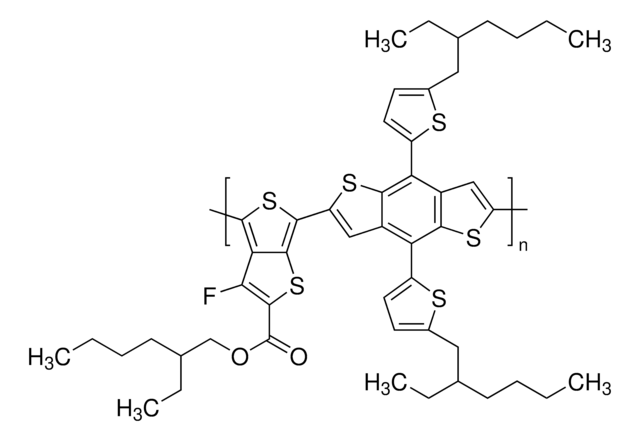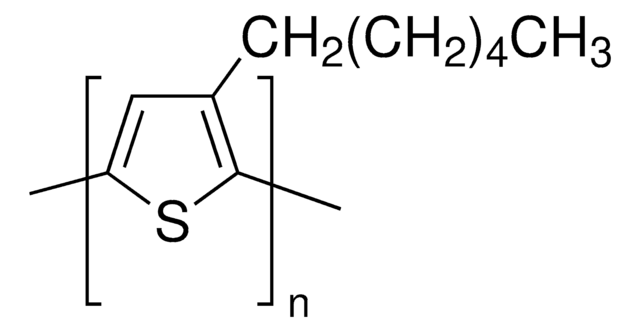おすすめの製品
詳細
Band gap: 1.9 eV
形状
solid
分子量
average Mw 100,000-140,000
損失
0.5 wt. % TGA, 409 °C
mp
270-300 °C
転移温度
Tm >400 °C
λmax
576 nm
軌道エネルギー
HOMO -5.5 eV
LUMO -3.6 eV
OPVデバイス性能
ITO/MoO3-Al/PCDTBT:PC71BM/MoO3/Al
ITO/PEDOT:PSS/PCDTBT:PC71BM (1:4)/TiOxAl
ITO/PEDOT:PSS/PCDTBT:PC71BM/Al
半導体特性
P-type (mobility=6×10−5 cm2/V·s)
類似した製品をお探しですか? 訪問 製品比較ガイド
詳細
アプリケーション
保管分類コード
11 - Combustible Solids
WGK
WGK 3
引火点(°F)
Not applicable
引火点(℃)
Not applicable
適用法令
試験研究用途を考慮した関連法令を主に挙げております。化学物質以外については、一部の情報のみ提供しています。 製品を安全かつ合法的に使用することは、使用者の義務です。最新情報により修正される場合があります。WEBの反映には時間を要することがあるため、適宜SDSをご参照ください。
Jan Code
753998-100MG:
753998-BULK:
753998-VAR:
この製品を見ている人はこちらもチェック
資料
The development of high-performance conjugated organic molecules and polymers has received widespread attention in industrial and academic research.
Optoelectronic Devices Based on Diketopyrrolopyrrole (DPP)-containing Conjugated Small Molecules
Optoelectronic Devices Based on Diketopyrrolopyrrole (DPP)-containing Conjugated Small Molecules
Organic photovoltaics (OPVs) represent a low-cost, lightweight, and scalable alternative to conventional solar cells. While significant progress has been made in the development of conventional bulk heterojunction cells, new approaches are required to achieve the performance and stability necessary to enable commercially successful OPVs.
ライフサイエンス、有機合成、材料科学、クロマトグラフィー、分析など、あらゆる分野の研究に経験のあるメンバーがおります。.
製品に関するお問い合わせはこちら(テクニカルサービス)

![ポリ[(9,9-ジ-n-オクチルフルオレニル-2,7-ジイル)-alt-(ベンゾ[2,1,3]チアジアゾール-4,8-ジイル)] average Mn ≤25000](/deepweb/assets/sigmaaldrich/product/structures/428/661/1c4ebb98-9d51-48c0-96c7-e556ca425aa4/640/1c4ebb98-9d51-48c0-96c7-e556ca425aa4.png)



![[6,6]-フェニル C71 酪酸メチルエステル、異性体混合物 99%](/deepweb/assets/sigmaaldrich/product/structures/716/624/9fb9f2f0-ae99-429f-8d3a-b12267976a4d/640/9fb9f2f0-ae99-429f-8d3a-b12267976a4d.png)



![ポリ[(9,9-ジオクチルフルオレニル-2,7-ジイル)-co-ビチオフェン] 99.9%](/deepweb/assets/sigmaaldrich/product/structures/309/000/8b4a3f54-7765-4aca-96c4-74ce328d455d/640/8b4a3f54-7765-4aca-96c4-74ce328d455d.png)